Camelbak M.U.L.E. Pro 14 100 oz Backpack
Reviewer: 5’10”, 155 lbs / 178 cm, 70 kg
Available Sizes: 14L
Materials: 200 x 290-denier nylon and 135-denier polyester with DWR treatments
Stated Volume:
- Total: 14L
- Usable storage excluding a full bladder: 11L
Stated Weight: 845 grams (1.875 lbs)
Blister’s Measured Weight (w/ empty bladder): 1003 grams
MSRP: $150
Test Location: Gunnison-Crested Butte, Colorado; Moab, Utah
Test Duration: ~4 months
- Air Support™ Pro Back Panel: Designed with body mapping technology to identify and ventilate the areas of the body that generate the most heat. Lightweight and breathable high pile mesh construction.
- 3D Vent Mesh Harness: Lightweight and breathable with added cargo. Designed for all-day comfort.
- Hip Belt With Cargo: Added stability and quick access to essentials
- Helmet Carry: Stow and secure helmet
- Integrated Tool Roll: Keep your CO2 cartridges, multi-tool, and tire levers safe and secure
- Adjustable Sternum Strap: Offers a range of adjustments for a custom fit and increased stability
- Impact Protection Ready: Compatible with the CamelBak Impact Protector™ (sold separately)
- E-Bike Battery Sleeve: Securely and safely ride with a second e-bike battery for all-day adventures
- Stretch Overflow Pocket: Quickly stash or shed an extra layer
- Cargo Compression: Cinch down jackets or other items to keep the footprint small
- Soft Lined Pocket: Keep your glasses or goggles safe and scratch-free
- Magnetic Tube Trap™ Management: Keeps your tube secure and accessible when you need it
- Reflectivity: For low light safety
- Light Loop: Clip on a light to make the ride to and from the trailhead safe
- Armor Carry: Stow and secure knee and elbow pads on the climbs
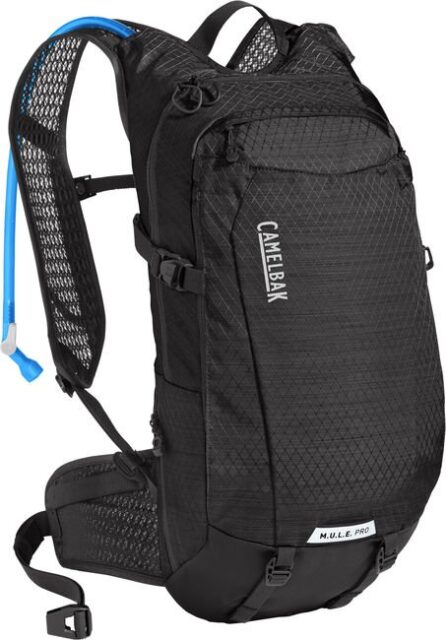
Intro
Camelbak invented the hydration backpack over three decades ago, and it’s been their specialty ever since. They’re one of the most widely-known producers of hydration products in the world, and their packs are commonly seen being used by hikers and mountain bikers on local trail systems.
The M.U.L.E. name, which stands for “Medium to Ultralong Endeavours,” has been in Camelbak’s lineup since the ‘90s and has been assigned to several iterations of hydration packs, all designed with cycling in mind. At 14 liters, the Mule Pro is the largest and highest-end Mule hydration pack currently in Camelbak’s lineup, though they do make dozens of other hydration packs that are both bigger and smaller than the Mule Pro 14, as well as a line of packs designed for military and tactical use.
The Mule Pro 14 100 oz is designed for all-day bike adventures, with room to carry the essentials as well as some extra emergency / luxury items you might not have room for in smaller packs. The Mule also comes in a 12L backpack as well as a 3L version for kids. Both the 12 and 14 L Mule come in unisex and women’s-specific versions, with the women’s versions designed with a slightly different fit meant to better suit women’s bodies. Apart from the fit, the women’s Mule Pro 14 backpack is the same as the unisex model that we’ll get into below.
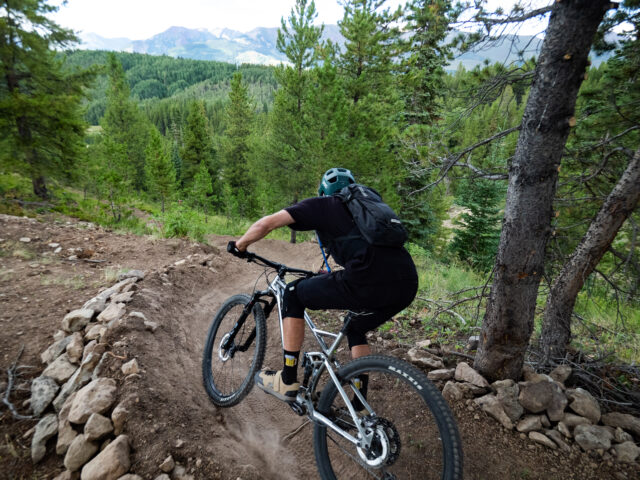
Design and Features
The Mule Pro 14 is divided into two main storage compartments — one closer to your back for the hydration reservoir and one for your gear. The gear compartment has an additional zippered internal pocket with two separate pouches designed to house tools. There’s also another pouch lower in the pack designed to carry a spare e-bike battery, but it could really be used for anything. The Mule Pro 14 also comes with a tool roll to keep all your items organized and together. I found that I was able to keep an entire flat kit, rain jacket, snacks, and whatever else I needed for the day in the pack quite easily, even with a full bladder. The hydration compartment opens from only one side of the pack, and in addition to having a space for Camelbak’s Impact Protector (basically a smaller, integrated version of a back protector), it houses the 3-liter (100-ounce) hydration bladder.
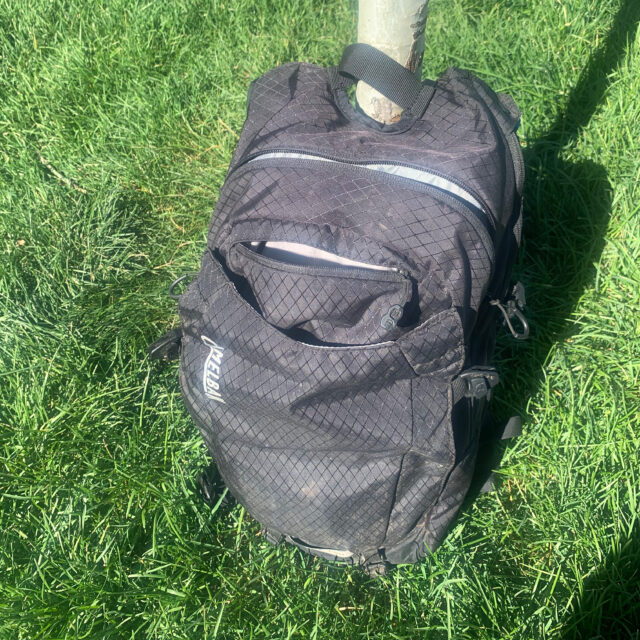
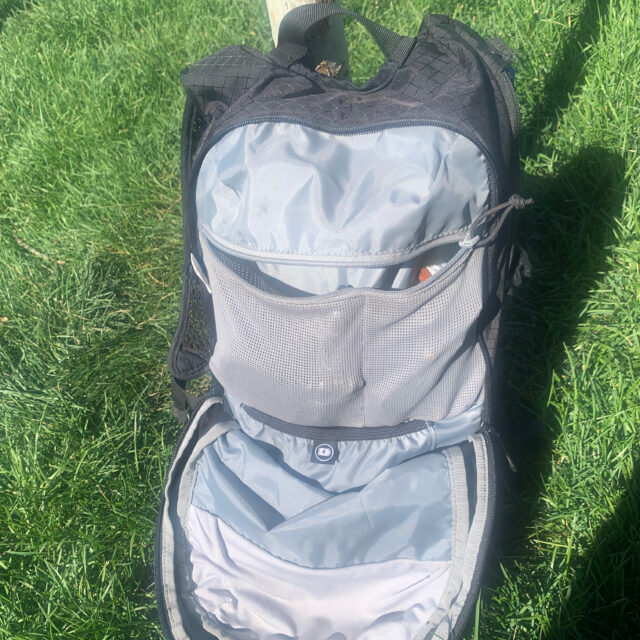
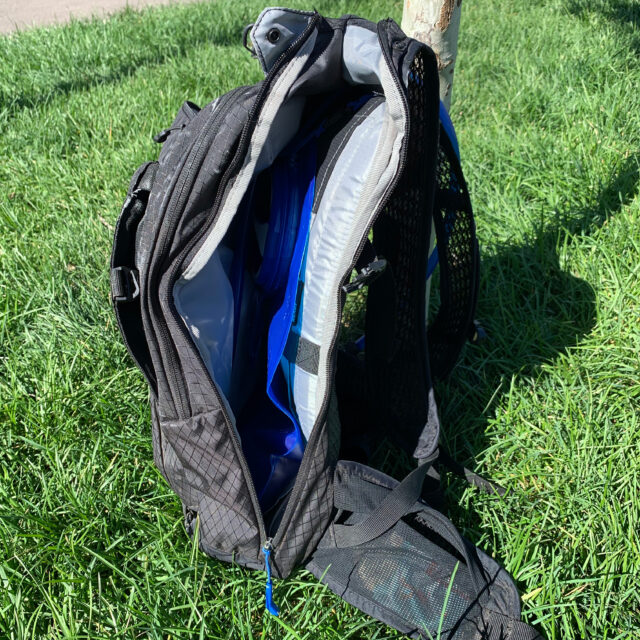

The included bladder is Camelbak’s Crux 3L reservoir. This is a vertically-oriented bladder that is similar in height to the pack, and it has a two-sided hook at the top built into the lid that hangs on a loop stitched into the pack. This bladder has a large, circular lid-style opening that is big enough to fill it with water without paying much attention and throw medium-sized ice cubes in with the water. Perpendicular with and attached to the lid opening (sitting flat on the bladder) is a short handle that makes filling up the bladder with one hand easy. At the base of the hose, you can quickly disconnect it to allow the bladder to be taken off separately from the backpack to be easily filled. Be careful, though — if water is in the hose, it’ll spill out the disconnected end. The drinking end of the hose features a high-flow bite valve with an on/off lever to prevent accidental spillage. The hose is relatively wide, stiff, and on the more durable end of the spectrum, which I was happy to see since I’ve used other hoses in the past that have developed kinks in them over time, and the Mule’s has not. The hose also features a magnetic clip that integrates with the sternum strap buckle on the pack. The reservoir and hydration hose also have an internal antimicrobial lining to prevent bacteria growth.
In addition to its main compartment, the Mule Pro 14 features several smaller pockets. One of them is a fleece-lined pocket near the top of the pack designed to carry glasses or goggles. Another is low on the pack, between the two large compartments, and accessed via a zipper on one side — I found it very handy for storing my cell phone. Last, it has two small pouches, one on each side of the hip straps. I found these very convenient for carrying snacks without needing to take off the pack, but they’re not ideal for rigid items like a cell phone — that would be pretty uncomfortable when tightened.

Finally, the Mule Pro 14 pack features a few external storage options for carrying some extra gear on your pack. First, it has two straps and buckles on the underside of the backpack, ideal for carrying things like knee pads, but anything relatively soft and cinch-able should fit just fine and stay in place here. Additionally, it has a large pouch on the outside of the pack for quickly stowing or accessing stuffable layers. This pouch as well as the rest of the pack can be compressed with straps on either side, and these straps can also be used for carrying a helmet. I am a firm believer in keeping my helmet on whenever I’m on a bike, but I could see this as being convenient for longer hike-a-bike situations with no danger of overhead rockfall.
The Mule Pro 14 also features a mesh back panel designed to make contact with your back and it creates some space between it and the pack, allowing for some airflow. This pack has a light foam skeleton that is designed to keep the pack somewhat rigid and prevent it from collapsing into the void left by this mesh panel. It’s less stiff than an option like the Dakine Seeker 18L and subsequently not as effective, but I was still able to appreciate winds finding their way to my back when descending fast, as well as crosswinds that come in at the right angle.
The Mule Pro 14 is a lightweight pack overall, and the shoulder and hip straps, which are mesh, are very supple and effectively breathable, even on very hot rides. They’re really pliable, though they’re also comfortable when tightened down on the body.
On The Trail
I’ll usually ride with a small or medium-sized fanny pack, but there are often times when I do need a larger pack, most commonly for carrying water on long, dry rides — rides for which it’s also wise to carry plenty of tools, snacks, and potentially layers. I enjoyed using the Mule Pro 14 on a variety of rides, from plunges down the waterless Whole Enchilada in Moab to a snowy casual Enduro race weekend, the Mule Pro 14 felt appropriate for it all.
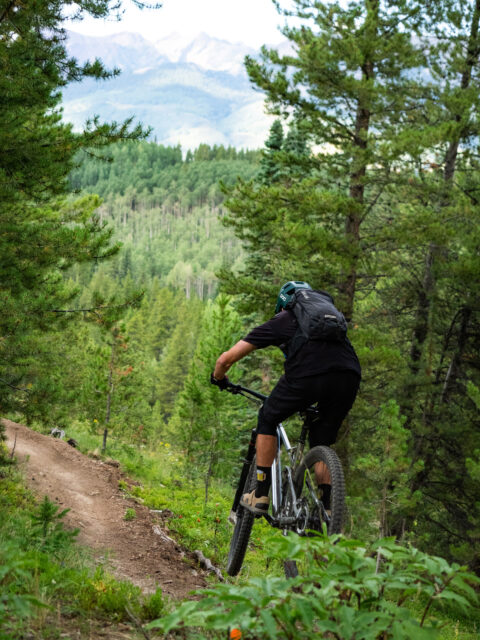
While I rarely packed it full, nothing bounced around within the pack so long as I cinched it down somewhat. Most of the heavy items like water and tools have their own compartments that keep the shifting around to a minimum. On longer day missions, the Mule 14 could fit just about anything I needed, including all the tools I needed for common on-the-trail fixes, a rain jacket, 3 liters of water, and plenty (often too many) snacks. Upon cinching down the hip and shoulder straps and making sure everything fit properly to my body, the weight of this full pack stayed sitting on my back without excessive movement.
I never utilized them, but the knee pad and helmet carry options seem easy to use and provide even more storage capacity, while reducing the amount of packing and unpacking of the backpack that is necessary to get your things. While I do enjoy lumbar-style hydration reservoirs that keep the most significant weight of the pack (water) close and somewhat low in the pack, I had no problems with the vertically-oriented reservoir in this pack. It’s very easy to fill with one hand, keeps its shape and stays in place well, and hasn’t leaked or punctured — mostly, I just forgot it was there, apart from the fact that it was supplying water to my mouth when I needed it.
As far as improvements I’d like to see made on this pack, I have a couple. When stuffed full of gear, the foam skeleton of this pack (behind the mesh back panel) deformed and bent outward toward my lower back, and was somewhat uncomfortable. With less gear inside, this didn’t happen, though. I bet Camelbak’s impact protector insert would also help this pack keep its shape better, but I’d also wager that most folks will be using the pack without it. I also found that the magnetic clip holding the hydration tube in place is effectively useless with the hydration hose coming from the right shoulder strap. This magnetic clip needs to be attached to the sternum strap buckle, which is on the left shoulder strap of this pack. Because of this, the hose ends up sticking out to the left of the left shoulder strap where it impacts my arm and gets knocked off the magnet. Routing the hose from the left side of the pack mitigates this, and I’ve been happy with it there.

Bottom Line
Camelbak is a name synonymous with hydration packs, and their experience with making water-carrying backpacks for mountain biking shows in the design and performance of the M.U.L.E. Pro 14 100 oz. It’s easy to make fit well, has enough storage for longer day rides, and is impressively breathable for a pack its size. It isn’t perfect, but it’s got a lot of features that beginner to expert mountain bikers could enjoy.
